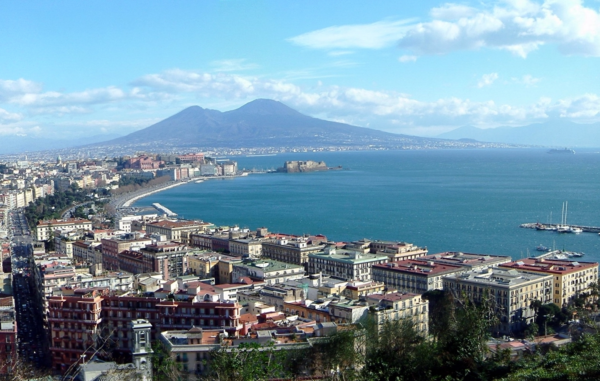 Naples is world famous for pizza, coffee, crèche artisans and music, both operatic at its magnificent 18th-century Teatro San Carlo and popular songs with lyrics in Neapolitan dialect sadly without a venue. That changed on October 15th when La Fondazione Trianon Viviani invited me and nine other foreign correspondents overnight to Naples. The occasion was the inauguration of “La Stanza delle Meraviglie” (“The Room of Marvels”) and the first live performance of the musical “Adagio Napoletano: Cantata D’Ammore” arranged by native-son set-and-costume designer Bruno Garofolo, at the Fondazione’s namesake theater.
Naples is world famous for pizza, coffee, crèche artisans and music, both operatic at its magnificent 18th-century Teatro San Carlo and popular songs with lyrics in Neapolitan dialect sadly without a venue. That changed on October 15th when La Fondazione Trianon Viviani invited me and nine other foreign correspondents overnight to Naples. The occasion was the inauguration of “La Stanza delle Meraviglie” (“The Room of Marvels”) and the first live performance of the musical “Adagio Napoletano: Cantata D’Ammore” arranged by native-son set-and-costume designer Bruno Garofolo, at the Fondazione’s namesake theater.
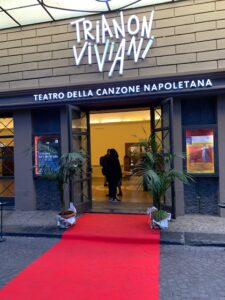
The facade of the Teatro Trianon Viviani Photo Credit: Lucy Gordan
Paolo Animato, the Theater’s Communications Director, and Marisa Laurito, its Artistic Director since 2020, welcomed us at the entrance, Animato opening our visit with a brief history. “In 1995, ”he said, “UNESCO declared the Historic Center of Naples, which includes our Teatro Trianon Viviani, a World Heritage Site. Founded in 1911 in the Forcella district, the city’s cultural heart since ancient Greek times, the theater’s repertoire has always centered on Naples, its playwrights and especially its music. Its long list of stars includes the comedy playwright, actor composer, poet and translator Raffaele Viviani (1888-1950), hence its name, the playwright and actor Eduardo De Filippo (1900-1984) with his siblings Peppino and Titina, comic actor and singer Nino Taranto (1907-86), comic actor, playwright, and poet Totò (1898-1967), singer Enrico Ruggeri, and singer Peppino di Capri. Owned from 1947 to 2006 by three-generations of the Cuccurullo family, since then it’s belonged to the Regione Campania, the Province of Naples, and now the City of Naples. Closed in 2014 because of a 500,000-euro debt, in 2015 The Governor of Campania Vincenzo De Luca saved it from transformation into a supermarket or bingo hall and oversaw its second restoration. During an earlier 2000-2002 restoration, an ancient Greek tower, dating to the 3th or 4th century BC and the only one still in existence in Campania, was incorporated on the right side of the orchestra pit. For it must not be forgotten that “Nea” “Polis” (“New City” in ancient Greek) was founded by the Greeks and area where Forcella is now was its center”.
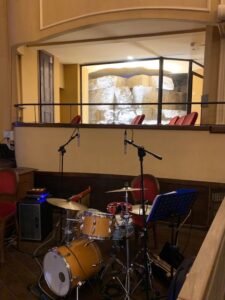
The Greek Tower Photo credit Lucy Gordan
“My present project,” explained Laurito, “has three parts; two will be permanent fixtures: ‘La Stanza delle Meraviglie’, and ‘La Stanza della Memoria’ to open at the end of the year. The third will be temporary musical productions, our first being ‘Adagio Napoletano: Cantata D’Ammore’, which you will see tonight.”
“Thanks to my project, sustained by the Region of Campania, our guardian angel Governor De Luca, and Scabec, (Società Campana Beni Culturali), Naples finally has a ‘popular music temple’. It was outrageous that until now Naples didn’t have a theater dedicated to performing its rich popular musical tradition. In Portugal there’s the fado; in Vienna the waltz; in Spain the flamenco; in New York Broadway’s musicals and in London’s West End too. The Trianon Viviani will soon be a money-making tourist attraction. I’m certain that descendants of Italian immigrants worldwide will soon buy tickets to learn more about their cultural heritage.” When I inquired about her favorite Neapolitan songs, Laurito answered: “’Era di Maggio’, ‘Mandullinata a Napule’, and ‘Quando tramonta il sole’, but I also love many others.”
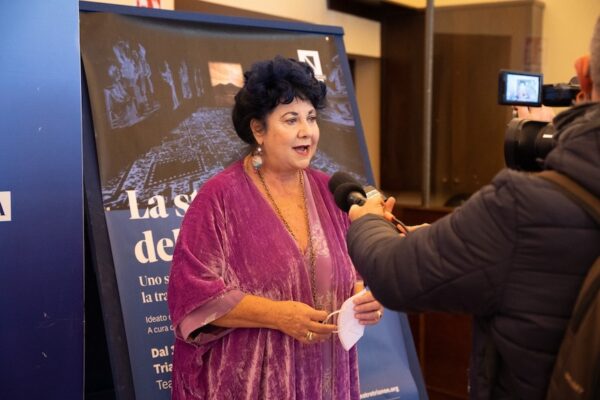
Marisa Laurito being interviewed Courtesy of La Fondazone Trianon Viviani
After Larito’s welcome, we entered the “La Stanza delle Meraviglie”, her brainchild with Garofolo, who, like Laurito, had collaborated with Eduardo De Filippo, but also with opera houses, theaters, and artistic festivals all over Italy. The “Stanza”’is a 30-minute-long medley of 17 Neapolitan songs, dating from 1880 to 1930, considered the “classical” period of Neapolitan songs. Using state-of-the-art digital technology Garofolo presents a mesmerizing multi-sensorial video, a musical “stroll” through Naples and environs. On screens along the room’s walls he projected paintings by 19th-century Neapolitan painters as background; videos of singers dressed in 19th-century outfits are superimposed on the paintings’ scenery as if participants. We too felt present in each scene. The songs’ themes are: streets and markets in Naples, the sea, and visits to towns along the Amalfi Coast. During our “stroll” the room’s floor changed from cobblestones, to the sea lapping at our feet, and to unpaved country paths. Entrance-free through November, the “Stanza delle Meraviglie” is open Monday through Saturday from 10 AM to 7 PM.

“Funiculi Funicula” Photo credit: Massimo Pica

Laurito and De Luca in “La Stanza delle Meraviglie” Photo Credit: Massimo Pica
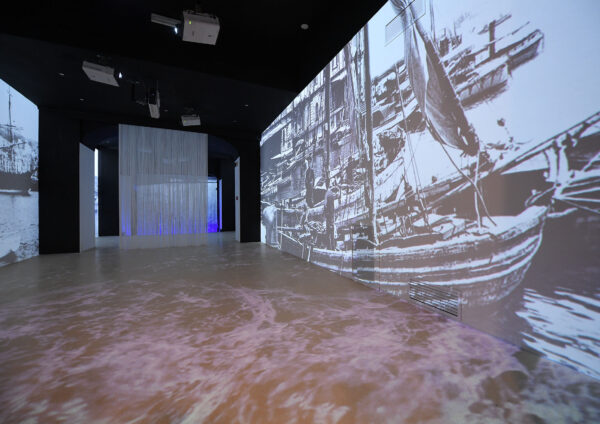
Sea Floor in “La Stanza delle Meraviglie” Photo credit: Massimo Pica
Instead, “La Stanza della Memoria”, curated by musicologist and composer Pasquale Scialò, will present, again digitally, in holographic display cases and on touch screens, recordings of Neapolitan songs from the 1880s to the present, their manuscripts, scores, posters, theater programs, pertinent photographs, and caricatures.
Before the curtain rose on “Adagio Napoletano: Cantata D’Ammore”, Animato recounted that: “Neapolitan songs became a formal institution in the 1830s thanks to an annual song-writing competition for the Festival of Piedigrotta, dedicated to the Madonna of Piedigrotta, a well-known church in the elegant neighborhood Mergellina. The winner of the first Festival was “Te voglio bene assaie”, a song traditionally, but without historical proof, attributed to the prominent opera composer Gaetano Donizetti ironically from Bergamo in very northern Italy, now famous as the first large city infected with Co-Vid 19. The Festival was held regularly until 1950.”
“A subsequent Festival of Neapolitan Song on Italian state-radio,” Animato continued, “enjoyed moderate success during the next decade, but Neapolitan songs, mainly about nostalgia for Naples, are world-famous because of the nearly 3,000,000 homesick Neapolitans and Southern Italians who immigrated to the USA from 1880-1920 and also thanks to native-son Enrico Caruso who sang them as encores at New York’s Metropolitan Opera in the early 1900s. Because of Caruso’s recordings of many, they became standard repertoire for operatic tenors: among others Beniamino Gigli, Franco Corelli, Mario del Monaco, Luciano Pavarotti, and still today Andrea Bocelli.”
“Since the 1950s their composers and most famous performers, all Neapolitans, have been: Totò, Renato Carosone, Pino Daniele, Gigi Alessi, Massimo Ranieri, and Roberto Murolo, whose collection of twelve LPs, released in the 1960s, is an annotated compendium of Neapolitan songs dating back to the 12th century. Since most were written for male soloists, their performers have been almost exclusively men. One exception, however, is Marisa Laurito!”
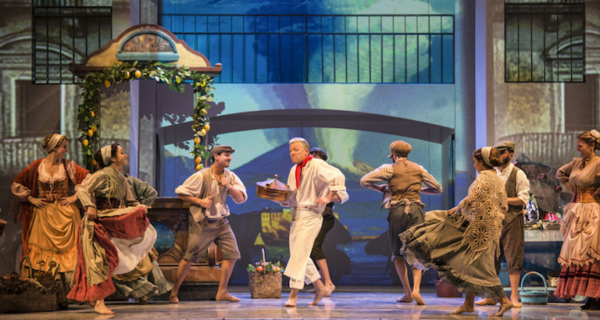
“‘O Pizzaiuolo Nuovo” in “Adagio Napoletano: Cantata D’Ammore” Photo credit: Pino Miraglia
“Adagio Napoletano: Cantata D’Ammore’s 38 Neapolitan songs, dating from 1885 to 1939, are divided between its eight scenes: Introduction, May and Roses, Immigrants, On the Street, Le Tammurriatte (a southern Italian folk dance similar to the better-known tarantella), Fishermen, The Market, Variety, and the Finale. Scheduled to open in situ in 2020, during the pandemic it was shown only on streaming. Future performances: November 26-28, December 25, 26, 30, and 31, January 2, February 25-27, March 12-13, April 15-17 and 22-24, and May 27-29. On Fridays the orchestra seats cost 25 euros and the others 20 euros; on Saturdays, Sundays and holidays, 28 and 22 euros. During the intervals a program of Neapolitan music and plays will be performed. For dates click on www.teatrotrianon.org. Tickets can be purchased online from www.azzurroservice.net.
Although I kept waiting to hear the more familiar songs like “O Sole Mio” or “Finiculi Funicula”, glued to my seat for the entire breathe-taking performance, during the encores I nodded: “Yes, finally, Marisa, you’ve achieved your goal: Teatro Trianon Viviani/Teatro della Canzone Napoletana is on a par with Broadway. Bravissima!
For years I’ve admired Marisa Laurito, a favorite TV personality in Italy, so MY main reason for coming to Naples had been to meet her in person. Born Naples on April 19th, 1951, ever-exuberant Laurito always aspired to become an actress. Entering Eduardo De Filippo’s stage company, she debuted in 1969 in “Le bugie con le gambe lunghe”. On her 21st birthday Laurito signed her first contract and, although she helped to found another Neapolitan stage company, during the second half of the 1970s, she performed in Eduardo De Filippo’s plays shown on RAI TV as well as in about 20 movies. Her popularity skyrocketed in the 1980s with Renzo Arbore’s TV variety show Quelli della notte and she went on to host several TV-programs, including two editions (1987 and 1990) of RAI’s Saturday night show Fantastico, connected to the National Lottery allotted on Epiphany., January 6. In 1989, perhaps for a lark, which would be in keeping with her bubbly personality, Laurito was a contestant at the San Remo Music Festival with the song “Il babà è una cosa seria”, ranking twelfth.
Since the year 2000 Laurito has dedicated herself to theater. Her three other passions are painting, Neapolitan songs, and gastronomy (her latest of several cookbooks is Pasta, Love, and Fantasia (2021). Also this year Rizzoli published her autobiography, Una vita scapricciata, loosely translated A Life Doing Everything I Enjoy.
If you’re staying on in Naples, visit the world-famous Archeology Museum, the painting and presepi collections at Capodimonte, the Cappella di San Severo, the presepi artisans on Via San Gregorio Armeno (this year’s novelty from Marco Ferrigno’s shop being the Re Magi presenting their green passes, now obligatory in Italy for entrance to restaurants, movies, theaters, stores, and long-distance travel on trains and airplanes), the dazzling Treasure of San Gennaro, Naples’ most important of 34 patron saints, the Duomo (Cathedral) next door, and, if you can find one, buy an opera ticket for the magnificent 18th-century Teatro San Carlo. Since traffic in Naples is always bumper-to-bumper, use the metropolitana (subway) for transportation. Many of its stations are works-of-art or house them. “This year,” Marco Ferrigno wrote on his website, “because of these difficult times we are living through, we wanted to add a touch of irony to our vast selection of presepi figures by introducing the Re Magi presenting green passes. We simply wanted to refer to a current event without any provocation or political reference.”
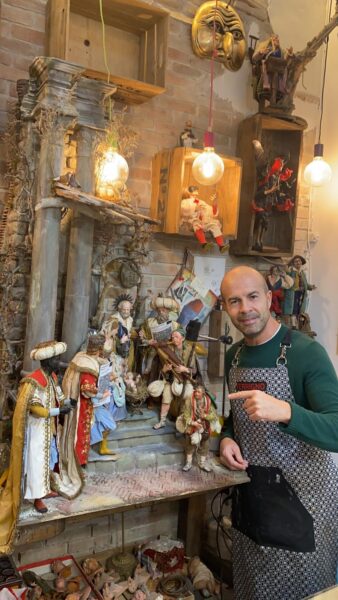
Marco Ferrigno with his Re Magi courtesy of Marco Ferrigno
As for pizza, Animato recommends “Pizzeria Trianon” a few doors down from the theater, “L’Antica Pizzeria Da Michele” and “Pizzeria 1947”, both nearby. Opened in 1923 by Ciro Leone and his wife Giorgina Somma and run today by two of their grand-daughters Donatella and Giorgina and their husbands, “Pizzeria Trianon” was a favorite of the actors Totò, Macario, and Nino Taranto. It’s famous for a pizza with a different topping on each slice and for another called “a ruotta di carretto” or “cartwheel” for its huge size. Founded in 1870 by the father of 13 children Salvatore Condurro and named for his son Michele, “Pizzeria Da Michele”, like the “Trianon” has always had a wood oven and is still run by the fifth generation of Condurro. It serves only pizza marinara and pizza Margherita. Scenes from “Eat, Pray, and Love” (2010), starring Julia Roberts, were filmed here. Instead “Pizzeria 1947” is famous the Neapolitan specialty “pizza fritta”. For non-pizza-lovers, “Mimmi alla Ferrrovia”, although touristy, is a must as are Michelin-recommended “Michelasso”, “George” and “Veritas” for their genuine gourmet Neapolitan cuisine.

“La Napoletana”
Neapolitans claim that Naples serves the best coffee in Italy. Their reason is threefold. Since Naples has always been a major port, the best coffee beans arrived here first. Secondly, it’s thanks to their copper flip coffee pot, the caffettiera napoletana known as “la napoletana” (Ironically it was actually invented by a Parisian, Jean-Louis Morize, in 1814 and patented in 1819). Thirdly, Neapolitans claim it’s due to the unique mineral content in the local water supply.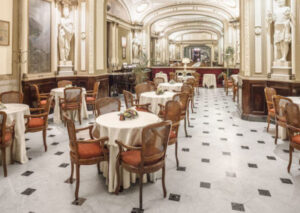
 Whatever the reason, for the best of the best, head to the elegant Belle Epoque Gran Caffè Gambrinus founded in 1860. It’s always been a meeting place for intellectuals and artists including the author Gabriele D’Annunzio, the founder of the Futurist artistic movement Filippo Tommaso Marinetti, Oscar Wilde, Hemingway, Guy de Maupassant, and Émile Zola, Eduardo De Filippo, Totò, and Marisa Laurito, to name only a few.
Whatever the reason, for the best of the best, head to the elegant Belle Epoque Gran Caffè Gambrinus founded in 1860. It’s always been a meeting place for intellectuals and artists including the author Gabriele D’Annunzio, the founder of the Futurist artistic movement Filippo Tommaso Marinetti, Oscar Wilde, Hemingway, Guy de Maupassant, and Émile Zola, Eduardo De Filippo, Totò, and Marisa Laurito, to name only a few.
In his Italian Journey (1786) Johann Wolfgang von Goethe wrote “See Naples and then die.” He identified Naples as the most naturally and artistically beautiful city in the world, so beautiful that one needn’t look upon anything else after seeing it. In fact, many Grand Tour travelers found it impossible to leave, only doing so upon dying. Goethe didn’t die in Naples, but he liked the city and the Neapolitans so much that it took him a month to leave.

Goethe Photo credit: Wkipedia
